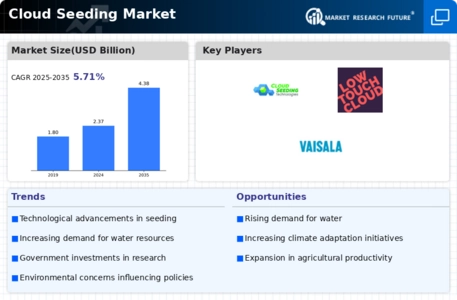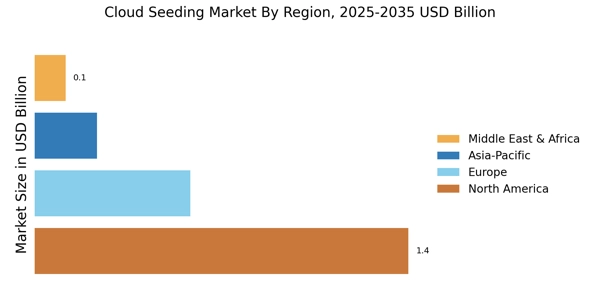The Cloud Seeding Market is currently characterized by a dynamic competitive landscape, driven by increasing demand for water resources and climate change mitigation strategies. Key players such as Weather Modification Inc (US), Aerial Weather Research (US), and Rain Enhancement Technologies (US) are at the forefront, each adopting distinct strategies to enhance their market positioning. Weather Modification Inc (US) focuses on innovation in cloud seeding technologies, aiming to improve efficiency and effectiveness in precipitation enhancement. Meanwhile, Aerial Weather Research (US) emphasizes partnerships with governmental agencies to expand its operational footprint, thereby enhancing its credibility and reach. Rain Enhancement Technologies (US) is actively pursuing regional expansion, particularly in arid regions, to address local water scarcity issues. Collectively, these strategies contribute to a moderately fragmented market structure, where competition is shaped by technological advancements and regional needs.
In terms of business tactics, companies are increasingly localizing manufacturing and optimizing supply chains to reduce costs and improve service delivery. The competitive structure of the Cloud Seeding Market appears to be moderately fragmented, with several players vying for market share. This fragmentation allows for diverse approaches to cloud seeding, as companies leverage their unique strengths to cater to specific regional demands. The collective influence of these key players fosters an environment where innovation and strategic partnerships are paramount, driving the market forward.
In August 2025, Weather Modification Inc (US) announced a collaboration with the state government of California to implement a large-scale cloud seeding project aimed at alleviating drought conditions. This strategic move not only underscores the company's commitment to addressing pressing environmental challenges but also positions it as a leader in state-sponsored weather modification initiatives. The partnership is expected to enhance the company's visibility and credibility, potentially leading to further government contracts in the future.
In September 2025, Aerial Weather Research (US) launched a new cloud seeding aircraft equipped with advanced technology designed to optimize seeding efficiency. This development reflects the company's focus on innovation and technological advancement, which may provide a competitive edge in the market. By enhancing the capabilities of its fleet, Aerial Weather Research (US) is likely to attract more clients seeking effective solutions for precipitation enhancement, thereby solidifying its market position.
In July 2025, Rain Enhancement Technologies (US) expanded its operations into the Middle East, establishing a new base in the United Arab Emirates. This strategic expansion is indicative of the company's intent to tap into emerging markets where water scarcity is a critical issue. By positioning itself in a region with high demand for cloud seeding services, Rain Enhancement Technologies (US) may significantly increase its market share and influence in the global landscape.
As of October 2025, current trends in the Cloud Seeding Market indicate a strong emphasis on digitalization, sustainability, and the integration of artificial intelligence in operational processes. Strategic alliances are increasingly shaping the competitive landscape, allowing companies to pool resources and expertise to tackle complex environmental challenges. Looking ahead, it appears that competitive differentiation will evolve from traditional price-based competition to a focus on innovation, technological advancements, and the reliability of supply chains. This shift may redefine how companies position themselves in the market, emphasizing the importance of sustainable practices and cutting-edge technology.


















Leave a Comment